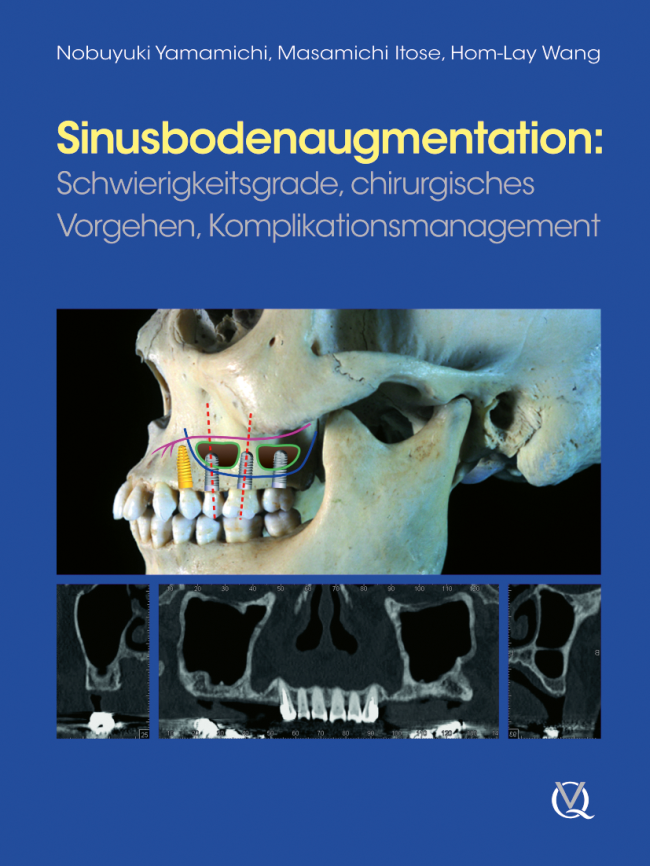The International Journal of Oral & Maxillofacial Implants, 4/2017
DOI: 10.11607/jomi.5290, PubMed ID (PMID): 28231348Pages 735-740, Language: EnglishSonoda, Tetsuya / Harada, Takehiro / Yamamichi, Nobuyuki / Monje, Alberto / Wang, Hom-LayPurpose: Maxillary sinus augmentation via crestal approach has been advocated as an alternative approach for sinus membrane elevation. Presently, no study has examined the relationship between the amount of bone grafting material placed and the final sinus membrane elevation height. Therefore, the present study was aimed at investigating the extent of sinus membrane elevation height depending on the amount of bone grafting material inserted as well as three-dimensionally assessing the likelihood of membrane perforation during membrane elevation.
Materials and Methods: A total of 34 subjects (16 females and 18 males) with 61 crestal sinus elevation sites were recruited. The following changes in elevated sinus membrane area were recorded: vertical elevation height (VEH), buccopalatal elevation (BPE), and mesiodistal elevation (MDE). Cone beam computed tomography (CBCT) was used to measure the elevated height of the maxillary sinus floor at the initial examination, during surgery, and immediately after surgery. In addition, the VEH:BPE and VEH:MDE ratios at each site were calculated using CBCT to determine the probability of sinus membrane perforation.
Results: In average, 0.1 mL of bone graft material placed elevated VEH an average of 3.5 mm, while 0.2 mL and 0.3 mL of graft placed elevated VEH 5 mm and 6 mm, respectively. Furthermore, it was demonstrated that the VEH:BPE and VEH:MDE ratios play a determinant role on membrane integrity. As such, a ratio greater than 1.0 may jeopardize membrane integrity, while a ratio ≤ 0.8 might represent a lower risk of membrane perforation.
Conclusion: An initial 0.1 mL of bone material filling can elevate sinus membrane vertically by 3.5 mm. To avoid sinus membrane perforation, a VEH:BPE or VEH:MDE ratio of ≤ 0.8 should be obtained.
Keywords: bone replacement graft, cone-beam computed tomography, crestal approach, endosseous implants, sinus augmentation
International Journal of Periodontics & Restorative Dentistry, 2/2008
PubMed ID (PMID): 18546812Pages 163-169, Language: EnglishYamamichi, Nobuyuki / Itose, Tatsumasa / Neiva, Rodrigo / Wang, Hom-LayThis study compared bone grafting regimens and different implant surfaces used for sinus augmentation and presented long-term implant success rates in augmented sinuses. Two hundred fifty-seven consecutive patients with 625 implants were evaluated retrospectively. In phase 1, 188 sinuses were grafted with (1) autograft alone; (2) autograft + demineralized freeze-dried bone allograft (DFDBA) + absorbable hydroxyapatite (AHA) in a ratio of approximately 1:3:3; or (3) DFDBA + AHA + nonabsorbable HA (NHA) in a ratio of approximately 1:1:1. In phase 2, grafting regimen 3 (combination of DFDBA + AHA + NHA) was used in another 69 patients. Data were analyzed based on bone grafting regimen, implant surface texture, and time of implant placement (immediate or delayed). In phase 1, graft type 3 had the lowest implant failure rate (2.7%), followed by type 2 (14.3%) and type 1 (44.4%). The overall implant failure rate was 3.6%. Smooth implants showed the highest failure rate (21.8%), followed by titanium plasma-sprayed (2.9%) and HA-coated (0.7%) implants. In phase 2, the overall implant survival rate was 92.5% after 3 years. Smooth implants showed the highest failure rate (41.7%), followed by sand-blasted, large-grit, acid-etched (6.8%) and HA-coated (3.4%) implants. All failures occurred when implants were placed simultaneously with sinus grafts. This study suggests that long-term implant success can be obtained when maxillary sinuses are augmented with a combination of DFDBA + AHA + NHA. Rough surfaces and delayed implant placement seem to increase implant success in these areas.




